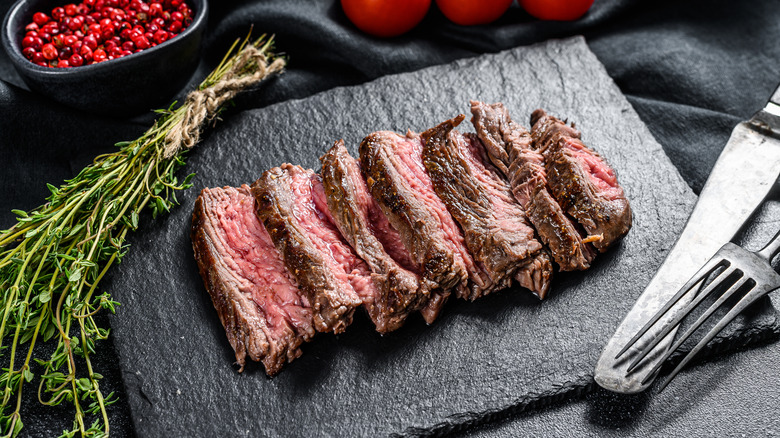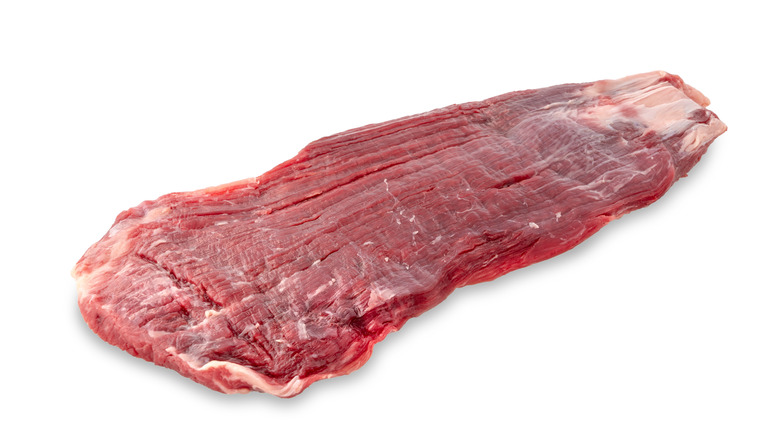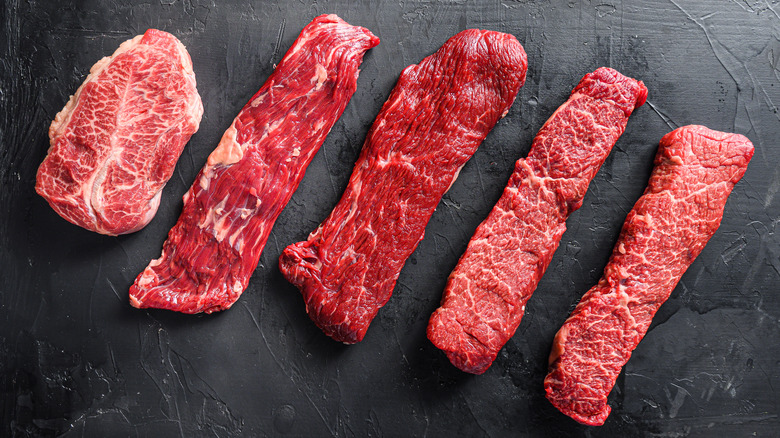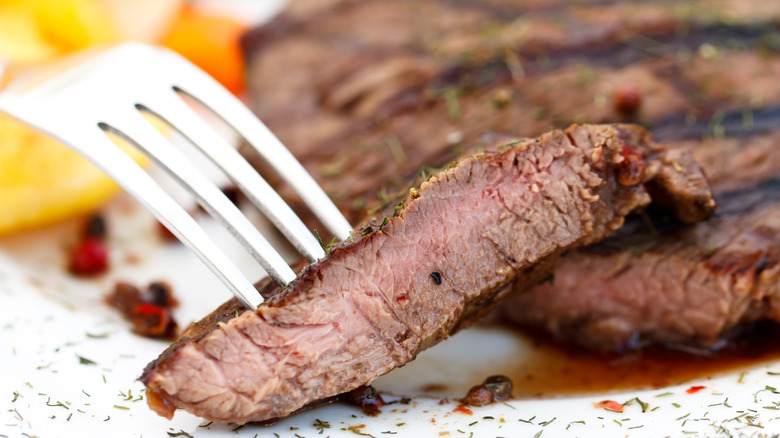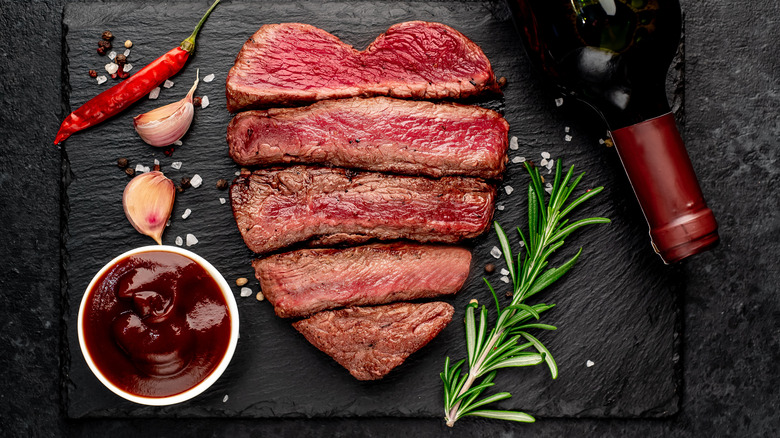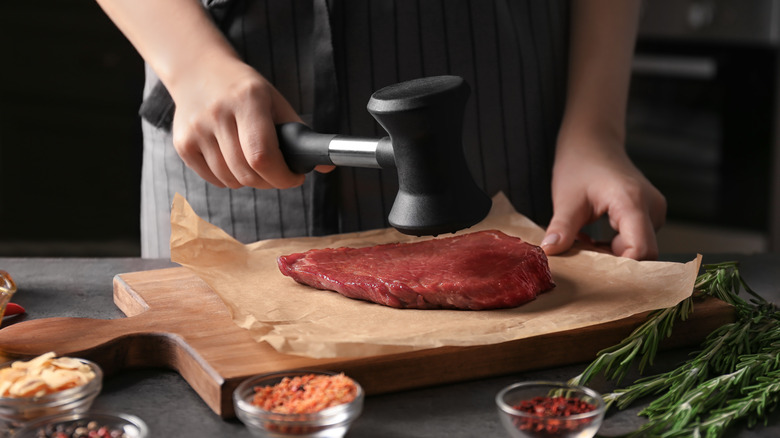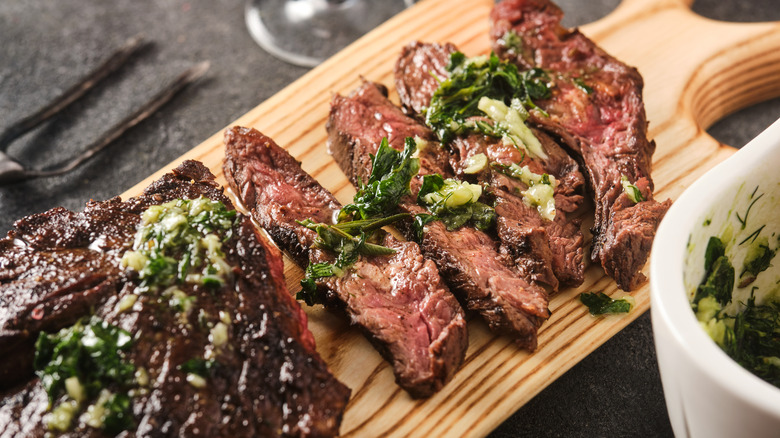What Is Flank Steak And How Do You Cook It?
Flank steak is technically not steak at all, at least according to Encyclopedia.com. It defines a steak as "high-quality beef taken from the hindquarters of the animal." To make matters more confusing, flank steak doesn't actually come from a cow's flank, either. The trusty OED tells us that a flank is "the side of a person's or animal's body between the ribs and the hip." Instead, The Spruce Eats reveals that flank steak is actually a cut of meat that comes from the cow's belly, or sometimes its lower chest. It still comes from a muscle, but the muscle in question is the abdominal one.
Looking at it, flank steak appears pretty much like any other cut of steak. It has the same deep red color before it's cooked, and develops the same type of browning on the outside. A closer look, however, will reveal one significant difference: flank steak really doesn't have much in the way of fat or marbling.
How to buy flank steak
One of the best things flank steak has going for it is the fact that it tends to be one of the most budget-friendly options in the beef section. Can't find any flank steak in your supermarket? This could be because it's going by another name. According to The Spruce Eats, this steak of many aliases may be sold under the names of London broil, jiffy steak, or, if the store's trying to be fancy, bavette. After all, everything sounds more high-end if you give it a French name.
You will usually find the flank steak in its natural habitat (that is, a Styrofoam tray covered in plastic wrap) sold in a cut that is about 12 inches long and 1 inch thick. Sizes, however, do tend to vary: flank steaks can range from one pound all the way up to about four pounds. For the most part, even the larger flank steaks tend to be sold whole rather than being sliced up into smaller cuts.
How does flank steak differ from other budget beef cuts?
Good Food Stories tells us that flank steak, along with skirt and hanger steak, was once used solely to grind up into hamburger meat since nobody seemed to want to buy them from the butcher shop. But as steak prices have risen over the years, so has the popularity of these cuts that were once considered to be at the bottom of the steak food chain.
The main difference between flank, hanger, and skirt steak is the part of the cow from which they were cut. The flank steak, as we've already mentioned, comes from the abdominal muscles. Skirt steak comes from the diaphragm, which isn't too far from where flank steak is cut, and hanger steak comes from the lower part of the belly near the ribcage. Of the three types, flank steak is the most versatile. Both flank and skirt steaks love to dive headfirst into a tasty marinade and soak it all up, but flank steaks, like hanger steaks, can be tender enough to stand on their own, so long as you cook and slice them with care.
What does flank steak taste like?
Flank steak's lack of fat means that it's obviously going to have a different mouthfeel than any cut that isn't quite so lean. If you want a chunk of meat you can really sink your teeth into rather than something that simply melts in your mouth, flank steak may just be the cut you've been looking for.
Flank steak's high concentration of pure meat with no fat and no frills results in this cut having a flavor that The Kitchn calls intensely "beefy." The Spruce Eats concurs, noting that flank steak's beefiness is "rich" and "assertive." In other words, flank steak might be a bit too large and in charge for some of the more delicate sauces and preparations that would suit a filet mignon. It will, however, stand up well in a boldly spiced and sauced dish. Any way you slice it (against the grain, please!), flank steak's flavor is sure to appeal to anyone who appreciates a really meaty-tasting meat.
Flank steak is one of the healthiest cuts of beef
According to Men's Health, flank steak is one of the best cuts of beef you can eat from a nutritional standpoint. Ounce for ounce, it packs more protein than either porterhouse or ribeye, and has fewer calories as well. If you were to chow down on a 6-ounce piece of flank steak — they say a serving size is 3 ounces, but come on, even the smallest of steakhouse offerings comes in at double that weight — it would provide you with 48 grams of protein and only 324 calories from your daily budget. 6 ounces of flank steak also has 12 grams of fat (6 saturated; 6 monounsaturated) and of course, a grand total of zero carbs.
Flank steak also provides significant amounts of important vitamins and minerals. With a 6-ounce serving, you'd get 72% of your recommended daily selenium, 60% of your niacin, 54% of your zinc, 48% of both your B6 and your B12 vitamins, and 36% of your phosphorus. The American Heart Association even offers a flank steak recipe as one of its "Heart-Check Certified" recipes, what's not to "heart" about that?
Flank steak may need to be tenderized prior to cooking
Flank steak does have somewhat of a bad reputation for being tough, but once you show it a little love and kindness (and maybe a splash of marinade), it can be quite tender. Or you can always get tough yourself, and bash it with a meat mallet a few times to teach it some manners. According to The Kitchn, if you're opting for the marinade method of tenderization, the more acidic, the better. Lemon juice, vinegar, and wine will all work, as well as more out-of-the-box (or bottle) ingredients such as yogurt, buttermilk, soda, or kiwi fruit. If you're going the mallet route, nestle your skirt steak between sheets of wax paper or plastic wrap and give it a good beatdown with any heavy object. If you don't have a mallet, cast iron skillets and rolling pins can serve a similar role.
Another method of tenderizing your steak would be to salt it heavily an hour before cooking, which will help break down the proteins. If you don't want a briny-tasting steak, you'll need to remember to rinse the salt off and pat the steak dry before cooking. You can also use a sharp knife to score a shallow diamond pattern against the grain of the flank steak. This will sever some of those longer muscle fibers and help make the meat easier to chew.
How to cook flank steak
According to Julia Collin Davison of America's Test Kitchen, "Flank steak is the boneless, skinless chicken breast of the beef world." She further explains that the meat "cooks quickly, there are no bones to fuss with, and you can use it to make everything from fajitas to stir-fries." Flank steak can be broiled in the oven or pan-seared (whole or sliced), but one of the best ways to cook this cut is by braising it. Cooking flank steak "low and slow" in your Instant Pot or Dutch oven will help to break down the meat's dense connective tissue and allow it to tenderize on its own without having to resort to mallet-based violence, per The Spruce Eats.
Some chefs consider flank steak to reach its peak of perfection when grilled. Marinating the flank steak prior to grilling is highly recommended; The Spruce Eats suggests something acidic, like pineapple or orange juice or wine. The Kansas City Steak Company adds that grilling time for flank steak should be kept to a minimum, noting that this cut is best enjoyed rare, medium-rare, or at most medium. Grilling instructions for both charcoal and gas grills involve searing the flank steak on high heat for a minute or two on each side, then reducing the heat to medium and cooking 9 to 12 minutes for medium rare, flipping the steak one minute before the halfway point. Rest your steak for 5 minutes, and enjoy.
